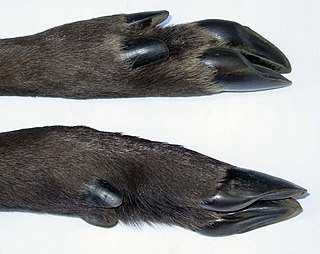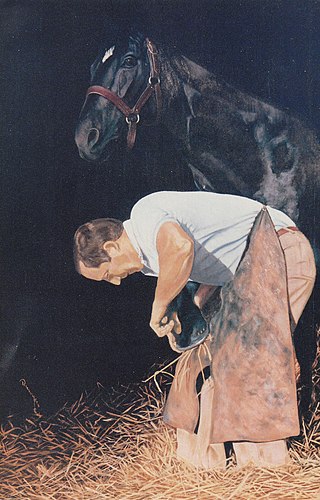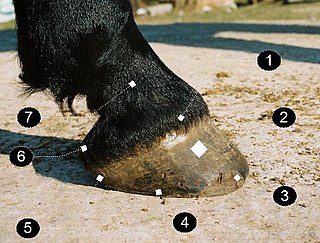
A horseshoe is a product designed to protect a horse hoof from wear. Shoes are attached on the palmar surface of the hooves, usually nailed through the insensitive hoof wall that is anatomically akin to the human toenail, although much larger and thicker. However, there are also cases where shoes are glued.

The hoof is the tip of a toe of an ungulate mammal, which is covered and strengthened with a thick and horny keratin covering. Artiodactyls are even-toed ungulates, species whose feet have an even number of digits; the ruminants with two digits are the most numerous, e.g. giraffe, deer, bison, cattle, goat, and sheep. The feet of perissodactyl mammals have an odd number of toes, e.g. the horse, the rhinoceros, and the tapir. Although hooves are limb structures primarily found in placental mammals, hadrosaurs such as Edmontosaurus possessed hoofed forelimbs. The marsupial Chaeropus also had hooves.

A farrier is a specialist in equine hoof care, including the trimming and balancing of horses' hooves and the placing of shoes on their hooves, if necessary. A farrier combines some blacksmith's skills with some veterinarian's skills to care for horses' feet. Traditionally an occupation for men, in a number of countries women have now become farriers.

Laminitis is a disease that affects the feet of ungulates and is found mostly in horses and cattle. Clinical signs include foot tenderness progressing to inability to walk, increased digital pulses, and increased temperature in the hooves. Severe cases with outwardly visible clinical signs are known by the colloquial term founder, and progression of the disease will lead to perforation of the coffin bone through the sole of the hoof or being unable to stand up, requiring euthanasia.
Navicular syndrome, often called navicular disease, is a syndrome of lameness problems in horses. It most commonly describes an inflammation or degeneration of the navicular bone and its surrounding tissues, usually on the front feet. It can lead to significant and even disabling lameness.

There are many aspects to horse management. Horses, ponies, mules, donkeys and other domesticated equids require attention from humans for optimal health and long life.
Jaime Jackson is a former farrier, horse hoof care lecturer, author, and researcher of the wild, free roaming horses in the U.S. Great Basin. He is best known for the practice of natural hoof care first written about in The Natural Horse: Lessons from the Wild (1992). His later work "Paddock Paradise: A Guide to Natural Horse Boarding" became a foundation for the alternative boarding system also known as Track System. Jackson's work focuses around Four Pillars of Natural Horse Care.
Dr. Hiltrud Strasser is a German veterinarian, who has worked for many years on the anatomy, physiology, pathology, and rehabilitation of horses' feet. She has published papers and books on this topic since the 1980s.

A horse hoof is the lower extremity of each leg of a horse, the part that makes contact with the ground and carries the weight of the animal. It is both hard and flexible. It is a complex structure surrounding the distal phalanx of the 3rd digit of each of the four limbs, which is covered by soft tissue and keratinised (cornified) matter. The arteries that supply the hoof with blood are, the vena plantaris externa and vena plantaris interna, which branch off the tibialis posterior. The horse hoof encapsules one of the three metatarsus bones that are found in the hoof and heel area.

A hoof boot is a device made primarily of polyurethane and is designed to cover the hooves of a horse as an alternative to, and occasionally in addition to, horseshoes. Hoof boots can also be used as a protective device when the animal has a hoof injury that requires protection of the sole of the hoof, or to aid in the application of medication. There are many different designs, but all have the goal of protecting the hoof wall and sole of the horse's hoof from hard surfaces, rocks and other difficult terrain.

A cattle crush, squeeze chute, cattle chute, standing stock, or simply stock is a strongly built stall or cage for holding cattle, horses, or other livestock safely while they are examined, marked, or given veterinary treatment. Cows may be made to suckle calves in a crush. For the safety of the animal and the people attending it, a close-fitting crush may be used to ensure the animal stands "stock still". The overall purpose of a crush is to hold an animal still to minimise the risk of injury to both the animal and the operator while work on the animal is performed.

Nail prick or quicking occurs in a horse if the sensitive hoof structures are penetrated by a horseshoe nail being driven through the hoof wall while shoeing. The nail creates a wound on the inside of the hoof wall.

A caulkin is a blunt projection on a horseshoe or oxshoe that is often forged, welded or brazed onto the shoe. The term may also refer to traction devices screwed into the bottom of a horseshoe, also commonly called shoe studs or screw-in calks. These are usually a blunt spiked cleat, usually placed at the sides of the shoe.

Natural hoof care is the practice of keeping horses so that their hooves are worn down naturally, or trimmed to emulate natural wear, so they do not suffer overgrowth, splitting and other disorders. Horseshoes are not used, but domesticated horses may still require trimming, exercise and other measures to maintain a natural shape and degree of wear.
The Defence Animal Training Regiment (DATR) is a training establishment, based in Melton Mowbray, east Leicestershire. It trains animals, of which the most numerous are dogs, for all three armed forces. Its headquarters are also the principal base of the Royal Army Veterinary Corps.

The Horse Protection Act of 1970 (HPA); is a United States federal law, under which the practice of soring is a crime punishable by both civil and criminal penalties, including fines and jail time. It is illegal to show a horse, enter it at a horse show, or to auction, sell, offer for sale, or transport a horse for any of these purposes if it has been sored.

Forensic podiatry is a subdiscipline of forensic science in which specialized podiatric knowledge including foot and lower-limb anatomy, musculoskeletal function, deformities and diseases of the foot, ankle, lower extremities, and at times, the entire human body is used in the examination of foot-related evidence in the context of a criminal investigation. Forensic Podiatry has been defined as:
The application of sound and researched podiatry knowledge and experience in forensic investigations, to show the association of an individual with a scene of crime, or to answer any other legal question concerned with the foot or footwear that requires knowledge of the functioning foot.
Bracy Clark was an English veterinary surgeon specialising in the horse.
Soring, or "big lick", is defined as the application of any chemical, mechanical agent, or practice inflicted upon any limb of a horse, that can cause or be expected to cause the horse to suffer physical pain or distress when moving. This results in the horses picking up their front feet higher and faster than they would do in their natural gait. Trainers use soring to give a horse a highly animated gait in a short time period rather than spending time training them to perform this gait naturally. People who sore their horses believe that it gives them a competitive edge over other horses in the show ring. However, soring is illegal in the United States under the Horse Protection Act of 1970. Tennessee Walking Horses are not allowed to be shown without passing a USDA and HPA inspection for soring and physical inspection; they are not allowed to have scars on their pastern as it is associated with soring. Other breeds that have a history of soring include the Racking Horse and the Spotted Saddle Horse.

Simon John Curtis is a farrier, author, lecturer and horse hoof-care expert with a PhD in Equine Physiology and Biomechanics (2017). He is a 4th generation farrier; his family have been farriers and blacksmiths in the Newmarket area for at least 150 years. In over 45 years working as a farrier, he has lectured and demonstrated in more than 30 countries including the USA, Australia, India, Russia, and Brazil.













